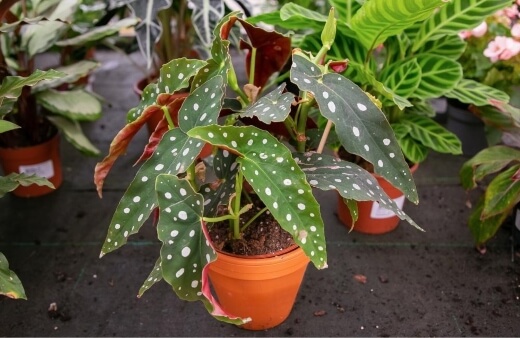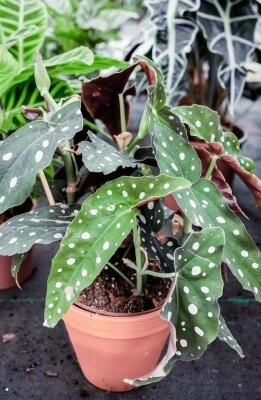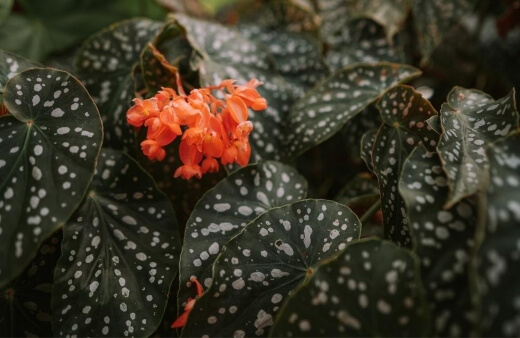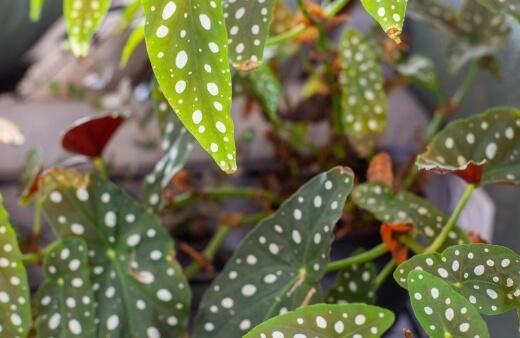Begonia maculata is a vividly patterned tropical plant, with bright white spots across deep green leaves, which hide a beautifully rich red underside. Also known as the Polka Dot Begonia, this fascinating plant is much easier to grow than it looks.
We’ve been growing Begonia for years, and love the variety they bring to a garden, so we’re thrilled to bring you our guide to growing Begonia maculata, one of the most rewarding tropicals you can grow in Australia.
More...

Family: | Begoniaceae |
|---|---|
Genus: | Begonia |
Species: | B. maculata |
Common Names: | Spotted Begonia, Polka Dot Begonia, Trout Begonia |
Location: | Indoor or outdoor |
Type: | Herbaceous Perennial |
Growth: | H 0.5 x W 0.5m (can reach 1m x 0.5m) |
Sun requirements: | Partial shade |
Foliage Colour: | Green leaves with white spots |
Flower Colour: | White |
Flowering: | Summer |
Fruit: | None |
Maintenance level: | Low |
Poisonous for pets: | Toxic to cats and dogs (particularly the roots) |
What is Begonia maculata?
Begonias fall into four different categories; wax begonias, tuberous begonias, rhizomatous begonias and hardy begonias. (Click here to learn more about these categories and the best Begonia varieties to grow in Australia here).
Begonia maculata is, technically, none of the above. Begonia maculata is a cane begonia, with a fibrous root system which means it is most closely related to wax begonias (and care is very similar).
This species is a summer flowering tropical plant, with striking spotted begonia leaves that form mounded clusters over-ground, or trail gorgeously from hanging baskets.
Polka Dot Begonia's Natural Habitat
The polka dot begonia was originally discovered in southeast Brazil and is found growing naturally in the Atlantic Rainforest in bright, dappled light and surrounded by consistent humidity.
It’s pretty tough to create rainforest conditions in most of Australia, but it’s still easy to grow these beautiful begonias outdoors, or indoors.
How to Grow Begonia maculata
Begonia maculata is pretty straightforward to grow but is far from low maintenance. The key to growing spotted begonia is humidity and dappled or filtered light.
Below, we’ll look at how to grow polka dot begonia indoors and outdoors in Australia.
Growing Polka Dot Begonia Indoors

Growing Begonia maculata indoors is simple: Provide bright, indirect light and good ventilation; water at regular intervals; and maintain slightly above average humidity.
If you can provide that, you’ll have a happy, spotted begonia that flowers routinely every year.
Sun / Temperature
Begonia maculata can grow in full sun but prefers dappled light. Consider rainforest conditions, where light is filtered through a tree canopy.
Either place slightly out of view of a north-facing window or directly in a west-facing window to get the warm late afternoon sun, rather than direct midday rays.
Soil / Drainage
While most Begonias need free draining soil to prevent root rot, Begonia maculata likes something slightly more moisture retentive, but not damp. The most important factor for Begonia maculata is aeration, so try to create a light soil mixture that air can penetrate.


Get Your Free Guide:
Master Growing Australian Natives eBook
A Must Have Complete Guide for Every Australian Garden
Get Your Free Guide:
Master Growing Australian Natives eBook
A Must Have Complete Guide for Every Australian Garden
For indoor Spotted Begonias, we use a mix of garden compost, perlite, and horticultural sand, in equal measure. Some soil mixes suggest grit rather than perlite, but it can hold moisture, and won’t add aeration in the same way as perlite.
Watering Begonia maculata Indoors
Water generously, but only when the soil has dried on the surface. To check when your indoor Begonia maculata is ready to water, stick your finger into the soil. If it is dry at the surface but has light moisture 2” deep it’s time to give it a drink.
Water until it runs out of the bottom of the pot, then do not water again until the surface has dried.
Humidity
The most common advice you’ll find is to grow Begonia in a naturally humid room. There are some problems with this. Most homes have two naturally humid rooms; bathrooms and kitchens. Both provide incredibly different conditions.
No matter what you cook, there will always be fats and oils suspended in kitchen steam, which can coat leaves, capture dust, and cause fungal problems and heat burn on the leaves of these tender perennials.
However, bathrooms are perfect. If you have a bright, north-facing bathroom, keeping your Begonias in the corner, with indirect sunlight is ideal.
The humidity from regular showers helps to steam the plant, warm its soil, and maintain healthy moisture levels. It also eliminates the need for misting, which can damage Begonias by leaving water droplets on leaves.
Ventilation
Any plant that requires high humidity also needs good ventilation. Humid environments foster bacteria and funguses so getting the balance right is crucial.
If you’re concerned about ventilation in your bathroom, keep begonia in the living room or a bedroom, and place it on a tray of pebbles. Moisten the pebbles regularly to provide light humidity in a better-ventilated space.
How to Grow Spotted Begonia Outdoors

Begonia maculata grow well outdoors in Australia and are much easier to care for than indoor-grown Polka Dots. Provide them with shade, and do not allow them to freeze.
Outdoor Begonia maculata can be grown in the ground, or in pots, provided they are in well-draining soil and kept reasonably well-watered through droughts.
Sun
Begonia maculata can be grown in full sun outdoors, but they are likely to suffer from sunburn, and you will see brown, crisp edges on their leaves quite regularly. It won’t affect the health of the plant, but it will affect the look.
For best results, grow Begonia maculata in well-drained soil, in partial shade, and avoid planting in the direct afternoon light.
Soil / Drainage
It’s much easier to manage outdoor begonias in pots as you can regulate their water, but in more temperate zones with good rainfall, planting them directly in the ground in particle shade means that you barely need to water them at all.
When planting, give them a good feed of garden compost, mixed through with horticultural grit. Mix that through the planting hole with garden soil and water them in really well.
Watering Spotted Begonias Outdoors
When first planted, begonias need a lot of water to help establish roots. Water newly planted begonias generously for the first few weeks until new growth is showing. After that, water whenever the soil is visibly dry.
More important than water is humidity. Begonias don’t like having wet leaves, so choose a spot near a pond, or a water feature so light humidity is always available on warm days to prevent the foliage from frying in hot Australian summers.
Now you know how to grow Begonia maculata it’s time to get out and buy one. Check online for good quality polka dot begonias, or find your local garden centre and support them by buying your next house plant there.
How to Propagate Begonia maculata
Tuberous and rhizomatous begonias have the wonderful advantage of being easy to propagate by division. Wax begonias do not. While you may occasionally find a stray Begonia maculata near your main plant this is likely from a rooted stem that has snapped from the plant, or from a dropped seed.
Begonia maculata is best propagated from cuttings, and as long as you can provide good enough humidity, moisture and warmth, it’s really quite easy.

Propagating Begonia maculata from cuttings
Most begonias can be grown from leaf cuttings, but Begonia maculata rarely takes well from leaf cuttings, so aim for nodal cuttings as it is much more reliable and produces roots far faster.
To take begonia cuttings:
- Cut a begonia leaf, including its stem just below a node (the knuckle where the leaf stem leaves the main stem)
- Dip the end of the stem in rooting hormone and place in a glass of water.
- Roots will start to appear after around 14 days, but keep them in place until the roots are 2-3” long.
- Change the water regularly, and provide support as the stems develop.
- After 2-3 months the roots should be strong enough to plant in the soil.
- Plant into loose, free draining compost, in a pot just large enough to accommodate the new roots.
- Water, then treat like any mature polka dot begonia.
There are different approaches to taking a plant cutting so be sure to check our complete guide on the types of cuttings to learn what they are, as well as when and how to do them.
Begonia maculata Pests and Diseases
Begonia maculata, like most tropical plants, suffers from pests and diseases as a result of poor growing conditions. In most cases, pests are attracted by the symptoms of overwatering or overexposure to the sun, and diseases are directly caused by high moisture, humidity, or sunburn.
Whether you grow your Begonia maculata indoors or outdoors, it will suffer from some of the following insects at some point in its life. It doesn’t mean you’re doing a bad job, it just means there are elements of care that need tweaking.
- Vine Weevil
- Earwigs and Caterpillars
- Spider Mites
- Eelworm
- Mealybug
Vine Weevil
Vine weevils are often mistaken for beetles and cause similar damage to plants, but they don’t have the ability to fly. Their black bodies are identifiable from their elongated snouts, and ridged backs.
To remove vine weevils from your plants, simply flick them into a bucket and dispose of them. We prefer putting them on the bird table, where they are quickly eaten by our garden birds.
Earwigs and Caterpillars
Begonia maculata must have incredibly tasty leaves because caterpillars from pretty much every family of moths appear in our garden every single year. Unlike most pests, caterpillars are a sign of a healthy plant, so take it as a compliment.
Try spraying the leaves with a fine mist of garlic tea which confuses moths (males are attracted to female pheromones, and garlic helps to mask that on prized plants) and will also help to reduce any slug damage.
Spider Mites
Spider mites are attracted to dry conditions, and are one of the biggest causes of fungal infections on plants. They are very likely through drought periods, so make sure to continue watering begonias well before dry spells to reduce the risk.
Spider mites are hard to see until there is a really bad infestation and leaves are covered in fine white silk. The best treatment is neem oil.
Mealybug
Mealybugs rarely affect outdoor begonia but are very prevalent on indoor potted begonias in particular. If you spot mealybugs, squish them! Neem oil, castile soap and organic pesticides work quite well, but will never completely eradicate mealybug infestations.
The white spittle-covered bugs are easy to spot, but hide well and cause fungal problems that usually start with small patches of white discoloration that later turn yellow as fungal spores multiply in the leaf.

Polka dot begonia really, really, hates damp soil. Try to avoid planting them anywhere that water doesn’t drain as it can cause a few significant diseases, including powdery mildew, leaf spot, root rot and stem rot.
On the other side of the same coin is the sunburn or sun scorch caused by high heat and direct afternoon sun.
Powdery Mildew
Powdery mildew affects most soft leaf plants, particular fibrous-rooted plants that try to regulate the water in their leaves like spotted begonia.
To prevent powdery mildew, make sure your begonia leaves stay dry through warm weather. Watering foliage on hot days is a sure-fire way to invite mildew funguses in.
Mildew needs moisture to multiply, but it also needs heat. Natural rainfall will wash off in cooler conditions without damage, but watering from a hose on a sunny day creates the perfect conditions for powdery mildew.
Leaf Spot
Bacterial leaf spot on polka dot begonias is frustrating but not devastating. If you notice patches of discoloured leaves just remove them and burn them.
Some gardeners will advise fungicides but they are never 100% effective so it’s always safer to remove any fungal infections from plants when you see them.
Root rot
Root rot is the result of persistently damp soil, usually in cool conditions. This creates two problems; 1/ water does not evaporate in low temperatures; 2/ roots that are waterlogged don’t take up nutrients and are starved of oxygen.
If the leaves of your begonia are beginning to look dry and wilted, but the soil around the base is wet, it is quite likely to be an early indication of root rot.
Take your Begonia maculata out of the soil and rinse its roots entirely. Remove any black, brown, or mushy roots and the associated top growth, then replant in fresh compost.
Stem rot
Stem rot can be caused by dozens of different bacterial and fungal pathogens, but one of the most common in Begonia maculata is southern blight. Southern blight is directly caused by wet, warm weather.
After dry periods, where plants have minute splits along their surface, heavy rainfall splashes onto the soil, throwing soil up onto the stems around the base of plants.
That soil can contain fungal spores, which get into the stem, creating mouldy growths, or black rot depending on the pathogen. It is very hard to fix, and the only definite way to stop the spread is to remove affected plants or cut back everything above the infected point.
Sun scorch
Sun scorch is simple to fix. While it is unlikely that scorched leaves will recover, they don't cause harm to the plant. Simply move indoor scorched plans to a cooler, more humid room.
For outdoor Begonia maculata with sun scorch, water them really well, or consider moving them somewhere more shaded.
Begonia maculata Frequently Asked Questions

Is Begonia maculata rare?
B. maculata is one of the most common houseplants in Australia and has become increasingly popular worldwide. While it is still rare in our gardens, it has been popular since the late 20th century.
Should you mist Begonia maculata?
You should not mist B. maculata as standing water on leaves promotes fungal problems like powdery mildew, and can even cause sun scorch in hot weather as droplets intensify the sun’s heat on foliage.
Why are my Begonia maculata leaves not red?
B. maculata can lose its red pigmentation on the underside of leaves due to drought or under-watering. The red pigmentation is a good sign of a healthy plant that is properly regulating its own moisture levels.
What does an overwatered Begonia maculata look like?
Overwatered B. maculata have yellowing leaves, and the vivid colouration will begin to fade. Brown tips on the leaves are a clear sign that overwatering has started to cause root rot, and is an indication that while water is present at the roots, the roots fail to take nutrients to the foliage.
Perk Up Your Garden by Growing Beautiful Begonia maculata
Begonia maculata will always have a special place in my home, but when I discovered this humidity-loving tropical plant could be grown outdoors, I couldn’t resist.
My favourite way to plant them now is in containers near the pond. Begonia maculata have free draining soil but seem to love the humidity on warm days and visible perk up in the afternoon.
Published on August 1, 2022 by Maisie Blevins
Last Updated on February 22, 2024




